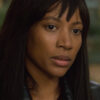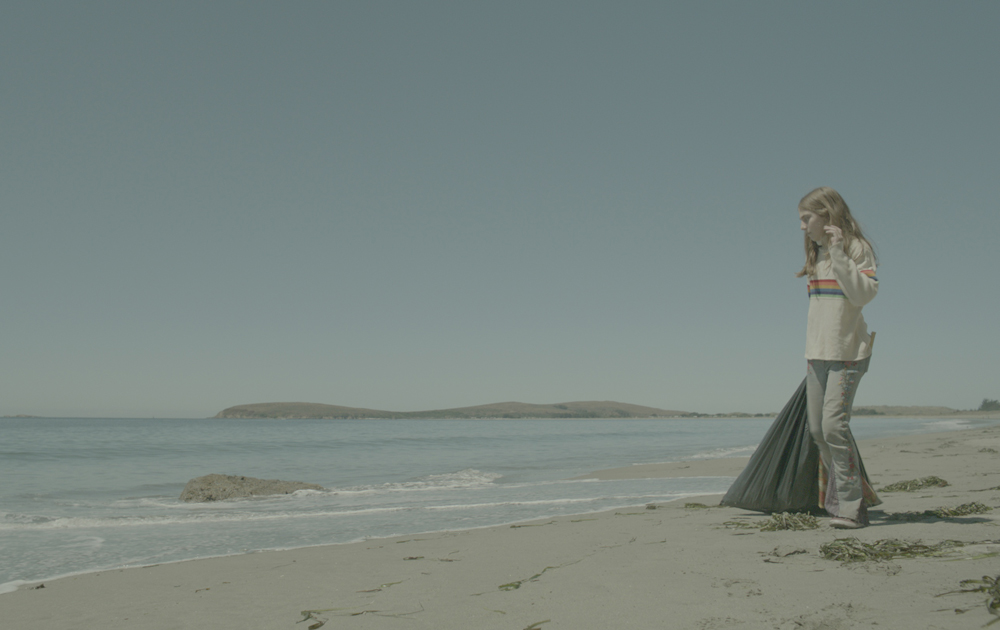For her feature debut “Lane 1974,” SJ Chiro needed a glass water pipe, and not just any glass water pipe but one in the shape of George Washington’s head. It was such a specific request that her production designer assumed that Chiro already had one hiding somewhere in her house that she could bring to set, but alas.
“I said, ‘No, I don’t have that,” Chiro laughs now. “But it is so specific because my dad had that pipe, and I wanted a lot of allusions to historical Americana. To [the production designer’s] credit, she searched and searched on eBay and found a a specialty alcohol bottle that had George Washington’s head on it and she drilled a hole carefully in it and made a pipe. It was pretty amazing.”
One could say the same about “Lane 1974,” in part because of the unmistakable authenticity evident in every frame of Chiro’s adaptation of Clane Hayward’s memoir “The Hypocrisy of Disco,” detailing the author’s days of growing up in communes along the California coast, but also in its bewitching evocation of growing up in a time and place where the children may have felt as though they were more mature than the adults raising them. Centering on a 13-year-old named Lane (Sophia Mitri Schloss) and her mother, the self-christened Hallelujah (Katherine Moennig), the film unfolds around Lane’s growing consciousness of mainstream society, her eyes widening when she sneaks a bite of a peanut butter and jelly sandwich on processed bread at a school she’s only allowed to go because a Social Security number or prior addresses aren’t asked for. Still, she finds herself at the mercy of a mother whose firm principles but lack of direction puts the pair, as well as her young brother and sister, increasingly in peril with no money to speak of and no physical home to call their own.
With the preternaturally poised Schloss as Lane, you suspect everything’s going to turn out alright, but that doesn’t keep “Lane 1974” from continually feeling revelatory as the world reveals itself to her. Having shared this same experience of growing up as an outsider to society herself, Chiro is able to precisely capture a more innocent time for both for Lane personally and for America when you’d think nothing of hitching a ride with a stranger in the middle of nowhere, but limns the edges of a world where the possibilities seem endless with the creeping self-awareness that the pursuit of freedom often creates its own limitations. While the film observes Lane discovering such boundaries, it’s beautiful to see how she begins to negotiate them for herself, something that is equally true of how Chiro finds her way as an artist to create the transcendent cinematic space “Lane 1974” exists in, using modern techniques to make the ‘70s-set tale feel so immediate and hitting the sweet spot in between her young protagonist’s sense of reality and imagination to show how the world is making an impression on her.
Ultimately, it is a film that leaves quite the impression on you, and following a premiere earlier this year at SXSW, Chiro is bringing “Lane 1974” to her native Pacific Northwest this weekend at the Seattle Film Festival. Shortly before what are sure to be some emotional screenings, the writer/director spoke about the near-decade-long journey to bring this story to the screen and getting the small details right that would prove to be so important later.
I’ve been thinking about how to talk about that time period for a really long time, but it wasn’t until a friend of mine called and alerted me to this book “The Hypocrisy of Disco” by Clane Hayward and I completely saw the throughline and I understood this girl and her world. I was totally inspired, and if you read the book, it’s a bit different than the film, but still, it offered me a way in to tell this story. That was 2008, so quite a while ago, but it’s been on my mind and I’ve been working it and working it for a really long time.
In some ways could it be seen as a blessing in disguise? I heard a funny story that Sophia was actually too young to play the part when you first met, but was the right age when shooting started.
You always have to look for the silver lining. [laughs] You get impatient and you’re just like come on, already, but then it all works out and it’s the way it was meant to be. I met [Sophia] when she was 10 and I got such a good vibe from her, but she had braces and was just too young for this role. When we reunited two years later, she had matured into just the right age and not only that, she’s the kind of actress that I love to work with because she delves in deep. She really wanted me to tell her all about the era and what kind of life Lane was living. She runs very deep and I went over to her house to read with her for the first time because actually she lives very close to me [laughs] and she had her whole notebook ready [with] all the color-coded highlighters, and questions to ask me. She read the book three times and she’s just very dedicated and thorough as an actress and the great thing about her is that she understands all this research is really important, but when you get on the set, you’re in the moment, so you just let it all go. She just did that so beautifully.
Because of how experiential this feels, how much room did you allow for surprises to happen on the set?
[Sophia] has a lot of experience with scripts, so it’s easy for her to adapt and if she had a problem with any line or anything like that, we would work it beforehand. That said, I can think of moments where she just lived it and improvised a little bit, but she’s very focused on what we’re trying to do as a group and Kate [Moennig], her co-star, really wanted that kind of freedom, so I I wanted them to feel very comfortable. I never wanted dialogue to feel stilted or staged or stale, so Kate really enjoyed that freedom and I think it started rubbing off on Sophia and she realized, oh, I can throw something in if I want.
Everyone asked me, “Can’t you just stay and shoot in Washington?” And really I felt like I couldn’t because the light was so specific in California that I needed, and I knew the locations and that we could get them for very cheap, if not free. So it would’ve been a lot easier to shoot those straight through in one location, but I felt it was important [to shoot in both locations] and I really give a lot of kudos to my producer Jennessa West for making it happen even though it was hard.
The Northern California shoot was on the land I knew very well because this is where I grew up and we shot on both the communes I grew up on. The house that the grown-ups are in, smoking pot [at the start of the film], that’s the house I grew up in. Then there were others we really had to search for, like the telephone booth when they’re leaving to go to the city. That was a tough location to find, which seems odd because [you’d wonder] what’s so big about this location? But we were really specific and needed a certain look. Even though we were importing the phone booth, it was bizarrely hard to find. It was originally written as a roadside gas station, but I think the location that we found ultimately worked.
Did the weather cooperate? You have some remarkable moments with fog and the way light hits.
Sometimes it cooperated and sometimes it didn’t, but in every case, it worked out anyway. Our first shoot back in Washington, when [you see in the film] the kids are hitchhiking back from school and they get a ride in the back of the truck, was a nightmare because it was just pouring. We had very little daylight because it was January in Washington, so we get through three-quarters of the scene and then it would dry up and we’d have to start all over, but the kids would be soaking wet and everybody just would be miserable. We had a new crew on because we were in Washington and this was the first day for our new first AD. [I thought] “This day is a wash” [when it was happening], but it turned out not to be a wash at all because some of my favorite shots are from that day with the light that you’re talking about, catching the hair of [Harry Curtis,] the kid that plays Jamie when the truck is coming up. It’s a little bit backlit and then there’s the rainbow, which we caught and it was like okay, we’ll just go with it. [laughs]
We also had two days on the beach and we had to truck everything in — and when I say truck, I mean all on our backs. We had a lot of camera equipment, props and everything else, and it was a roasting hot day. Sophia was in her sweater, because it was directly after [the scene where the kids] were hitchhiking from the school, so now she’s coming to the beach and I don’t think you can tell how hot it really is [by watching the film], but she was requesting, “Can I take off this sweater?” It was hard because we needed the continuity, but I just said, “Of course, we’ll just shoot you taking off the sweater once you get to the camp site.” I thought she was going to pass out for a minute because it was so hot, and Kate [Moennig] was all in layers because she gets so cold, but she was roasting on that day and the very next day it was freezing, [which] was when we were shooting the drowning scene, and that’s what I wanted. There were so many birds out and we shot the heck out of that, so it’s a good thing our days were not reversed – like a sunny day for the drowning and a wintry day for arriving to the camp site. It all worked out. [laughs]

I really had to walk a line between being true to the era and then also be real that we’re telling the story now. For instance, the opening is an homage to films like “The Shining” and “McCabe and Mrs. Miller” where somebody takes a long time coming to a location and there’s credits over it, which was an homage to the era, and I thought initially, it would be great to shoot this all in 35mm, but in retrospect, I’m really glad we didn’t because it speaks exactly to what you’re talking about. Obviously, we wouldn’t have had the Alexa in the 1970s, but I think it gives it that freshness that helps an audience to connect with it and not make it a museum piece.
But that was totally the intention and [with the music,] my composer Jason Staczek did a lot of the emotional, vulnerable music and there were various different groups and bands and musicians that contributed pieces. Three different songs were specifically made for this film — the two that took place [when Lane visits] Puma, the girl in the city, and our temp music [for that scene] was The Stylistics and The Spinners, but I actually really liked the idea of not having recognizable music that [still] will take you back to your own time, and to create this whole world that is specific to itself. There’s a musician up here, Mike Sylvester, who used to be a part of this band called Fly Moon Royalty and he really took on that challenge of getting a really era-specific sound, but creating it now. He’s younger than I am and did not experience the ‘70s, so it was a challenge for him, but I really liked what he ended up doing. Then the other song that I needed specifically for this film was the last disco song at the very end, which had to sound pretty different than anything that we had heard so far. It’s ushering in a new era — a new era for [Lane], and for America really, and there’s so many different kinds of disco music, so he had to fill a lot of my requirements, but he did a nice job.
There’s also another friend of mine who’s a Northwest musician named Tomo Nakayama and I was absolutely obsessed with one of his songs while I was writing the film. I could not stop listening to it in my car on repeat, and ultimately, he was kind enough to give it to us for the film. That piece of music is when the kids are still on the commune and they’re walking to the other house [and it’s] romanticizing childhood a little bit, but there’s a slight edge of darkness too. There was one other musician [Kelley Stoltz], a Bay Area musician who’s actually a friend of the author Clane Hayward, so she hooked me up with him and I just thought [the music in general] was so gorgeous and I was so grateful to all the musicians that contributed their music.

When I was in college, I spent some time in Paris, and I didn’t know anyone there, so I spent tons of time in the little neighborhood movie theaters. Even before that, my dad worked for the university and he would take us to the films the university would show, so I wasn’t just seeing blockbusters. Actually, one of the films I saw there was a huge reference for this film — “Walkabout.” So cinema has always been something that I’m excited about and interested in, but I was devoting a lot of my time to theater [early on] and there was a lot of crossover too. I come from an acting background, so although there is a very different style of acting for film than there is for theater, there’s a lot of commonality as well.
What’s it like to bring the film home to Seattle?
I’m so excited because everybody who knows me here has just heard me for the past nine years talk about nothing else. [This film] just has enveloped my entire psyche, my whole being and anyone who knows me has contributed to this film in one way or another, so to finally see it come to fruition and [for everyone to] see what I’ve been working on all these years is just going to be incredible. I can’t wait.
“Lane 1974” does not have U.S. distribution. It will play at the Seattle Film Festival on June 2nd at the Egyptian Theater at 7 pm and June 3rd at the SIFF Cinema Uptown at 2:30 pm.






Comments 1